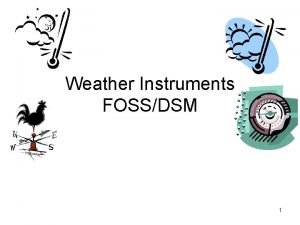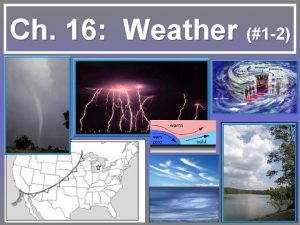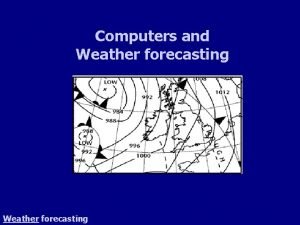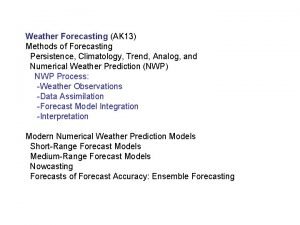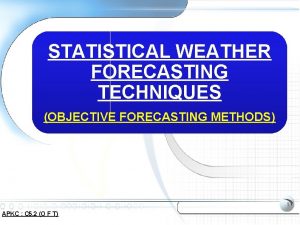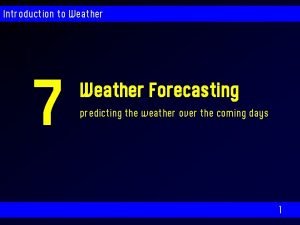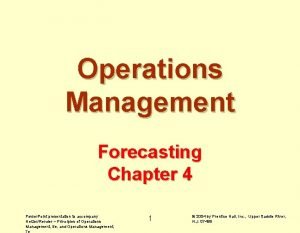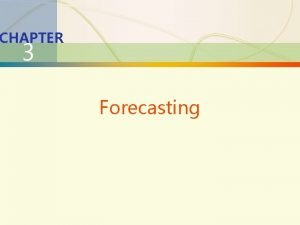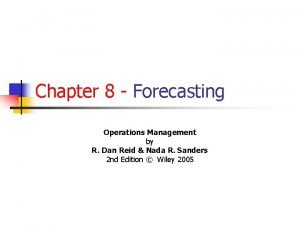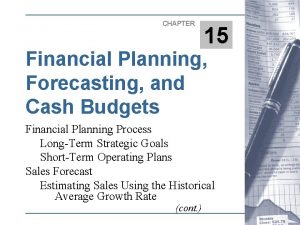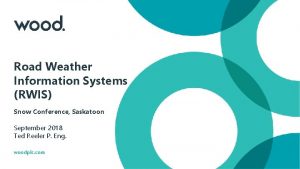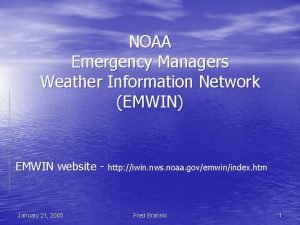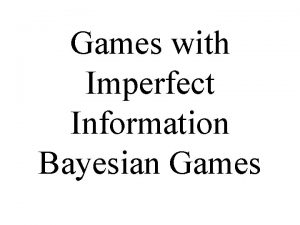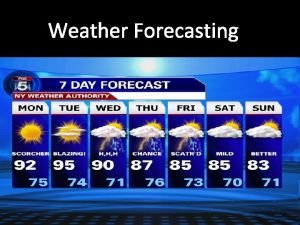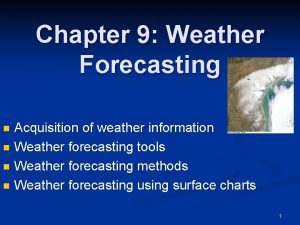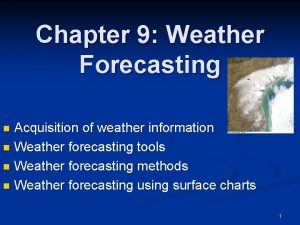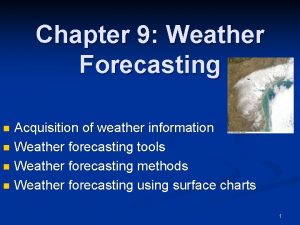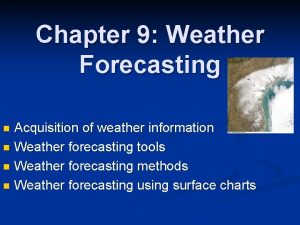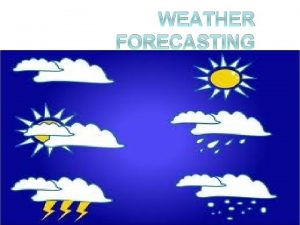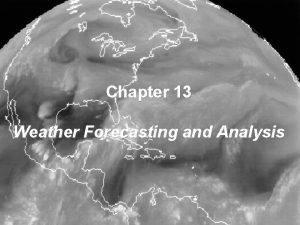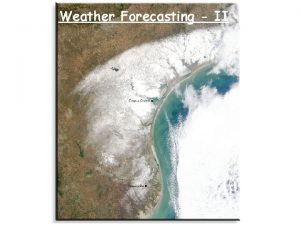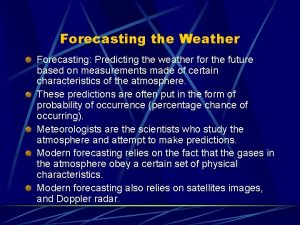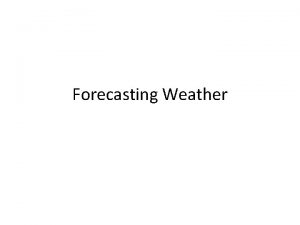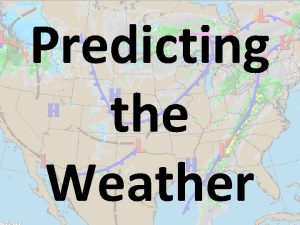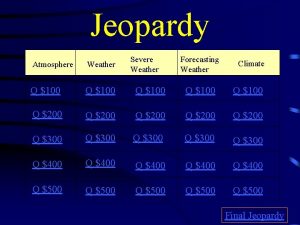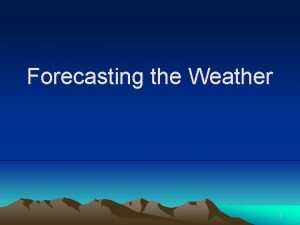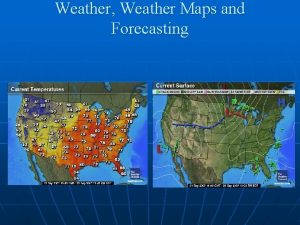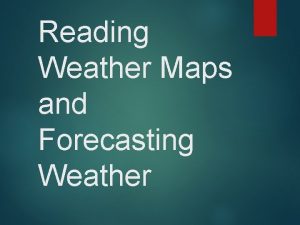Chapter 13 WEATHER FORECASTING Acquisition of Weather Information


























- Slides: 26

Chapter 13 WEATHER FORECASTING

Acquisition of Weather Information 10, 000 land-based stations, hundreds of ships and buoys; four times a day, airports hourly Upper level: radiosonde, aircraft, satellites United Nations World Meteorological Organization, 175 countries World Meteorological Centers: Melbourne, Moscow, Washington D. C. NCEP, US NWS ASOS

Weather Forecasting Tools High speed data modeling systems (AWIPS): communication, storage, processing, and display Doppler radar Satellite imagery Forecast charts Soundings Wind profiles




Weather Forecasting Tools Topic: Watches, Warnings, and Advisories: potential hazardous conditions; wind, wind chill, heat, urban and small stream, snow, dense fog Watch: atmospheric conditions favoring hazardous weather over a region in time, actual location and time not known; flash flood, severe thunderstorm, tornado, hurricane Warning: imminent or occurring hazardous weather over a region in time; high wind, heat, flash flood, severe storm, tornado, hurricane, winter storm, blizzard, gale, storm

Weather Forecasting Methods 1950 s maps, charts plotted by hand Numerical weather prediction Solves equations using gridded data Final chart called analysis 24 hr forecast for the N Hemisphere requires millions of calculations Resolution Guidance/ rules of thumb





Weather Forecasting Methods Topic: Thickness Charts Difference in height between two constant pressure surfaces (100 mb-500 mb) Higher thickness equals warmer air Why Forecast Go Awry Assumptions Models not global Regions with few observations Cannot model small-scale features All factors cannot be modeled Ensemble Forecasts: Spaghetti model, robust


Weather Forecasting Methods Other Forecasting Techniques Persistence Trend Analogue Statistical Weather type climatological



Weather Forecasting Methods Observation: Weathercasters Chroma key or color separation Types of Forecasts Now cast <6 hrs Short range 12 -65 hrs Medium range 3 -8. 5 days Long Range >8. 5 days Accuracy and Skill 12 -24 hrs most accurate, 2 -5 days good Skill = more accurate than a forecast utilizing persistence of climatology

Weather Forecasting Using Surface Charts Observation: Advection Winds that back with height indicate cold advection (counterclockwise) and vice versa Movement of Weather Systems 1. Mid-lat cyclones move in same direction and speed as previous 6 hrs 2. Lows move in direction parallel the isobars in the warm air ahead of the cold front 3. Lows move toward region of greatest pressure drop

Forecasting : Accuracy and skill A persistent forecast or climatological forecast is often accurate. Forcasting a warm sunny day in LA during the summer is often accurate. To show forecast skill the forecaster must do better than either the persistent forecast or climatological forecast. Correctly Forecasting a rainy day during the summer in LA takes skill.




Stepped Art Fig. 13 -15, p. 359


 Krashen's monitor model
Krashen's monitor model Weather instruments
Weather instruments Ch 16 weather
Ch 16 weather Computers in weather forecasting
Computers in weather forecasting Persistence method of weather forecasting
Persistence method of weather forecasting Weather forecasting techniques
Weather forecasting techniques Introduction to weather forecasting
Introduction to weather forecasting Brainpop humidity
Brainpop humidity Collecting information and forecasting demand
Collecting information and forecasting demand Collecting information and forecasting demand summary
Collecting information and forecasting demand summary Defense acquisition management information retrieval
Defense acquisition management information retrieval Operations management chapter 4 forecasting solutions
Operations management chapter 4 forecasting solutions Chapter 3 forecasting
Chapter 3 forecasting Forecasting in operations management
Forecasting in operations management Chapter 15 financial forecasting for strategic growth
Chapter 15 financial forecasting for strategic growth Weather model symbols
Weather model symbols Tongue twister winter
Tongue twister winter Whether the weather poem
Whether the weather poem Sunny rainy cloudy stormy
Sunny rainy cloudy stormy Weather vs whether
Weather vs whether Heavy weather by weather report
Heavy weather by weather report Capital weather gang weather wall
Capital weather gang weather wall Road weather information systems
Road weather information systems Emergency managers weather information network
Emergency managers weather information network Complete vs perfect information
Complete vs perfect information Managerial judgement method
Managerial judgement method Color forecasting
Color forecasting

